日本政府4月13日早上召开相关阁僚会议,正式决定向海洋排放福岛第一核电站含有对海洋环境有害的核废水。日本福岛核事故造成放射性物质泄漏,对海洋环境、食品安全和人类健康产生了深远的影响。从二十世纪50年代开始到现在,核电已经发展了60多年。在这60多年的发展过程中,发生了多次重大的核事故,每一次核事故的后果都会影响整个世界。今天让我们一起回顾人类历史上造成了重大影响的核泄漏事故。
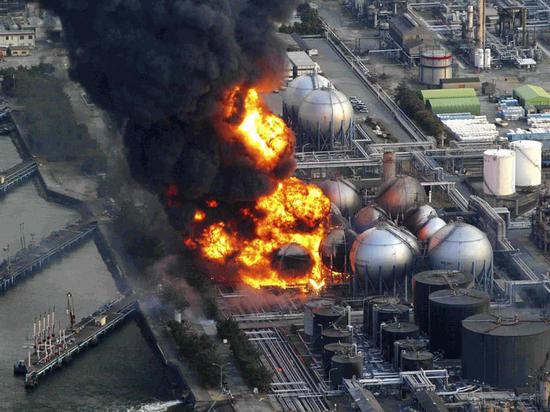 福岛第一核电站泄漏事故
福岛第一核电站泄漏事故Fukushima Daiichi
Fukushima, Japan, March 2011
福岛第一核电站泄漏事故
地点:日本福岛,2011年3月
The earthquake and tsunami that struck eastern Japan on March 11, 2011, caused a serious accident at the Fukushima Dai-ichi nuclear power plant on the northeastern coast of Japan.
2011年3月11日发生在日本东部的地震和引起的海啸,导致了在日本东北海岸的福岛第一核电站发生了严重泄漏事故。
How did it happen?
The earthquake cut off external power to the reactors. Tsunami, which reached levels more than twice as high as the plant was designed to withstand, disabled backup diesel generators, crippling the reactor cooling systems. Battery power was quickly exhausted, and overheating fuel in the plant's operating reactor cores led to hydrogen explosions that severely damaged three of the reactor buildings. Fuel in three of the reactor cores melted, and radiation releases from the damaged reactors contaminated a wide area surrounding the plant and forced the evacuation of nearly half a million residents.
核事故是如何发生的?
地震切断了反应堆的外部电源。海啸的水位高出核电站设计承受能力的两倍多,核电站的备用柴油发电机失效,从而严重影响反应堆的冷却系统。电池电量迅速被耗尽,运行中的核反应堆堆芯中过热的燃料导致氢气爆炸,严重破坏了三座反应堆建筑物。三个反应堆堆芯中的燃料融化,损坏的反应堆释放的放射性物质污染了核电站周围的广阔区域,迫使近半百万居民撤离。
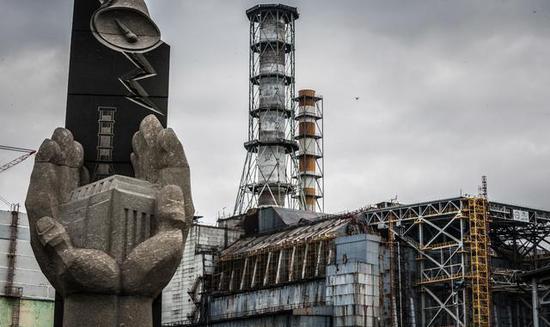 切尔诺贝利核事故
切尔诺贝利核事故Chernobyl
Chernobyl, Ukraine (former Soviet Union), April 26, 1986
切尔诺贝利核事故
地点:乌克兰(前苏联)切尔诺贝利,1986年4月26日
Chernobyl is considered the world’s worst nuclear disaster to date. It occurred on April 26, 1986, when a sudden surge in power during a reactor systems test resulted in an explosion and fire that destroyed Unit 4. Massive amounts of radiation escaped and spread across the western Soviet Union and Europe. As a result of the disaster, approximately 220,000 people had to be relocated from their homes.
切尔诺贝利被认为是迄今为止世界上最严重的核灾难。它发生在1986年4月26日,当时在反应堆系统测试期间突然出现功率激增,导致爆炸和火灾,并摧毁了4号机组。大量的放射性物质逸出并散布在整个苏联西部和欧洲。这场灾难的结果是,大约有22万人不得不逃离自己的家园。
How did it happen?
Unit 4 was to be shut down for routine maintenance. A test was conducted to determine the plant equipment’s ability to provide sufficient electrical power to operate the reactor core cooling system and emergency equipment during the transition period between a loss of main station electrical power supply and the start-up of the emergency power supply. Workers did not implement adequate safety precautions or alert operators to the electrical test’s risks. This lack of awareness led the operators to engage in actions that diverged from safety procedures. Consequently, a sudden power surge resulted in explosions and nearly complete destruction of the reactor. The fires that broke out in the building contributed to the extensive radioactive releases.
核事故是如何发生的?
4号机组当时即将关闭以进行日常维护。在此之前进行了一项测试,以确定核电站设备在失去主站电源和启动应急电源之间的过渡期,是否具有提供足够的电能以运行反应堆堆芯冷却系统和应急设备的能力。工作人员没有采取足够的安全预防措施,也没有提醒操作员有关这项电源测试的风险。缺乏安全意识的操作员没有按照安全程序进行操做。因此,突然的电涌导致反应堆爆炸并几乎完全毁坏。建筑物中发生的大火导致大量放射性物质泄漏。
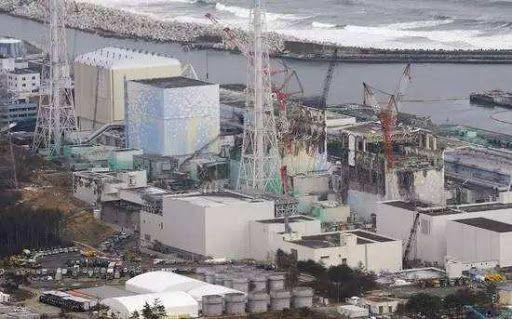 三哩岛核事故
三哩岛核事故Three Mile Island
Middletown, Pennsylvania, USA, March 28, 1978
三哩岛核事故
地点:美国宾夕法尼亚州米德尔敦,1978年3月28日
The partial meltdown at Three Mile Island Unit 2 is considered the most serious nuclear accident in U.S. history, although it resulted in only small radioactive releases.
三哩岛2号机组的部分融化被认为是美国历史上最严重的核事故,尽管此事仅导致少量放射性物质泄漏。
How did it happen?
The accident began with failures in the non-nuclear secondary system, followed by a human-operated relief valve in the primary system that stuck open, which allowed large amounts of nuclear reactor coolant to escape. Plant operators’ initial failure to correctly identify the problem compounded it. In particular, a hidden indicator light led to an operator manually overriding the automatic emergency cooling system because he mistakenly believed that too much coolant water in the reactor had caused the steam pressure release. Eventually the reactor was brought under control, although the full extent of the accident was not understood until later.
核事故是如何发生的?
事故始于无核二回路的故障,随后是主要系统中的人工操作的卸压阀卡住,从而使大量核反应堆冷却剂外泄。操作员最初未能正确识别问题,这使问题更加复杂。尤其严重的问题,是隐藏的指示灯导致操作员手动关闭自动紧急冷却系统,因为他错误地认为反应堆中的冷却水过多导致了蒸汽压力释放。最终,反应堆得到了控制,而直到后来人们才了解到事故影响的全部范围。
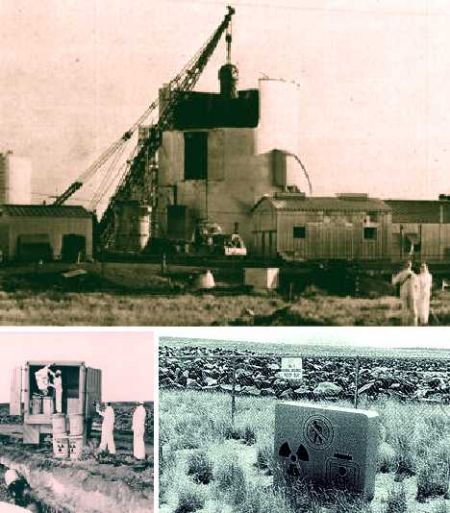 美国国家反应堆试验站事故
美国国家反应堆试验站事故SL-1
Idaho Falls, Idaho, USA, January 3, 1961
美国国家反应堆试验站事故
地点:美国爱达荷州爱达荷瀑布,1961年1月3日
The withdrawal of a single control rod caused a catastrophic power surge and steam explosion at the SL-1 boiling water reactor that killed all the workers on duty at the time.
单个控制棒在SL-1型沸水反应堆中撤出,造成了灾难性的电涌和蒸汽爆炸,导致当时所有工作人员丧生。
How did it happen?
On January 3, 1961, workers were in the process of reattaching to their drive mechanisms control rods they had disconnected earlier that day to enable test equipment to be inserted in the reactor core. They lifted the central control rod 20 inches, instead of the four inches that was required. This error caused the reactor to go critical and its power to surge 6,000 times higher than its normal level in less than a second. As a result, nuclear fuel vaporized and a steam bubble was created. The steam bubble expanded so quickly that it pushed water above it against the reactor vessel, which caused it to jump out of its support structure. It hit an overhead crane and then returned to the reactor vessel. In the process, all of the water and some of the fuel was released from the reactor vessel. All three workers on duty received lethal doses of radiation, in addition to trauma from the explosion.
核事故是如何发生的?
1961年1月3日,工作人员为了将测试设备插入反应堆堆芯,断开了驱动机构控制棒,操作完成后重新将驱动机构控制棒接入。他们将中央控制棒拔出了20英寸,而不是所需要的4英寸。该错误导致反应堆进入临界状态,并且其功率在不到一秒钟的时间内就比正常水平高出6,000倍。结果,核燃料蒸发并形成蒸汽泡。蒸汽气泡迅速膨胀,将其上方的水推向反应堆容器,导致其跳出支撑结构。它撞上了高架起重机,然后返回反应堆容器。在此过程中,所有水和部分燃料从反应堆容器中泄漏出来。除爆炸造成的伤害外,所有三名值班工作人员均受到了致命剂量的辐射。
注:SL-1(英语:Stationary Low-Power Reactor Number One,中文翻译为固定低功率反应堆1号),是美军的实验性核动力反应堆
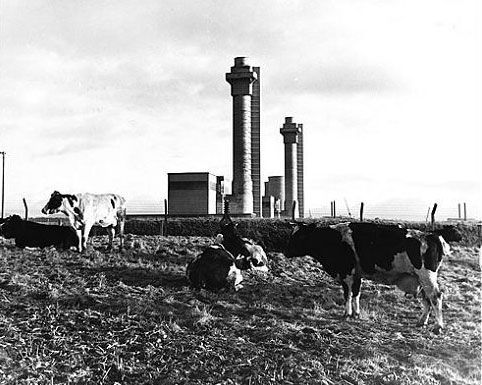 温茨凯尔反应堆大火
温茨凯尔反应堆大火Windscale
Cumberland (now Cumbria), UK, October 10, 1957
温茨凯尔反应堆大火
地点:英国坎伯兰郡(坎布里亚郡),1957年10月10日
Windscale Unit 1’s core caught fire and melted, which led large amounts of radioactivity to be released to the surrounding area.
温茨凯尔反应堆1号机组的堆芯着火并融化,导致大量放射性物质释放到周围区域。
How did it happen?
Before the accident, Unit 1 was activated to release built-up energy in the graphite of the core. The fuel was cooler than the normal operating temperature and was warming more slowly than expected. A second release led to a higher temperature than workers expected. Eventually the temperature was more than 750 degrees Fahrenheit, so air was vented to cool it. The reactor caught fire, igniting an estimated 11 tons of uranium. Workers first used carbon dioxide to try to put out the fire, but that strategy failed. Next they used water, which eventually succeeded. It took workers a total of three days to put out the fire. In the meantime, radiation escaped through the chimney and contaminated much of the surrounding area and reached as far as mainland Europe. More than 200 cancer deaths are attributed to the disaster, which is considered to have been the worst to occur in the West.
核事故是如何发生的?
事故发生之前,1号机组被激活以释放积聚在堆芯石墨中的能量。燃料比正常运行温度低,并且升温速度比预期慢。第二次释放导致温度高于工作人员的预期。最终温度超过华氏750度,于是工作人员排出了空气以对其进行冷却。该反应堆随即着火,点燃了约11吨铀。工作人员首先使用二氧化碳试图扑灭大火,以失败告终。接下来,他们使用水,最终成功将火扑灭。工作人员总共花了三天时间才扑灭大火。同时,放射性物质通过烟囱逸出并污染了周围的大部分地区,影响远至欧洲。这场灾难造成了200多人死于癌症,被认为是西方最严重的核灾难。
【相关词汇】
放射性物质泄:radioactive material leak
核能发电厂,核电站:nuclear power plant
核反应堆: nuclear reactor
冷却系统:cooling system
反应堆堆芯:reactor core
核反应堆冷却剂:nuclear reactor coolant
控制棒:control rod
【知识点】
国际核事故分级

国际核事故分级标准(International Nuclear Event Scale, INES)制定于1990年,作为核电站事故对安全影响的分类,旨在设定通用的标准以及方便国际核事故交流通信。INES由国际原子能机构(international atomic energy agency, IAEA)和经济合作与发展组织(Organization for Economic Co-operation and Development , OECD)的核能机构(nuclear energy agency, NEA)设计,国际原子能机构(IAEA)监察。
核事故分级类似于用于描述地震的相对大小的矩震级。每增加一级代表事故比前一级的事故更严重约10倍。相比于事件强度可以定量评估如地震,而人为灾难的严重程度如核事故,更多的是受制于解释。因为解释的难度在于事件发生很久之后,事故的INES等级才被评定。
核事故分为7级,灾难影响最低的级别位于最下方,影响最大的级别位于最上方。最低级别为1级核事故,最高级别为7级核事故, 但是相比于地震级别来看,核事故等级评定往往缺少精密数据评定,往往是在发生之后通过造成的影响和损失来评估等级。7个核事故等级又被划分为2个不同的阶段。最低影响的3个等级被称为核事件,最高的4个等级才被称为核事故。